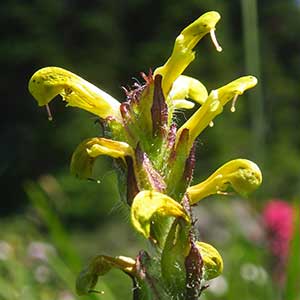Pedicularis rainierensis
Pedicularis parryi
Mt. Rainier lousewort
Parry's lousewort
basal 2–5, blade lanceolate, 40–80 x 3–20 mm, 2-pinnatifid, margins of adjacent lobes nonoverlapping or slightly overlapping distally, serrate to 2-serrate, surfaces glabrous;
cauline 2–6, blade lanceolate, 15–70 x 5–20 mm, 1- or 2-pinnatifid, margins of adjacent lobes nonoverlapping or slightly overlapping distally, serrate, surfaces glabrous.
basal 4–20, blade elliptic or lanceolate to oblanceolate, 10–70 x 3–15 mm, 1-pinnatifid, margins of adjacent lobes nonoverlapping or slightly overlapping distally, 1- or 2-serrate, surfaces glabrous;
cauline 0–20, blade lanceolate, 10–50 x 2–10 mm, 1-pinnatifid, margins of adjacent lobes nonoverlapping or slightly overlapping distally, serrate, surfaces glabrous or tomentose.
simple, 1–4, exceeding basal leaves, each 10–50-flowered;
bracts lanceolate or subulate to trullate, 10–15 x 1–2 mm, undivided or pinnatifid, proximal margins entire, distal serrate, surfaces glabrous or tomentose.
simple, 1–10, exceeding basal leaves, each 5–50-flowered;
bracts subulate to trullate, 10–25 x 8–10 mm, undivided or +/- lobed, proximal margins entire, distal serrate or crenate, surfaces glabrous or tomentose.
1–3.5 mm.
2–3 mm.
calyx 7.5–11 mm, hispid to tomentose, lobes 5, linear to narrowly triangular, 4–5 mm, apex entire, glabrous or ciliate;
corolla 16–19 mm, tube light or dark yellow, 8–10 mm;
galea light or dark yellow, 8–9 mm, beakless, margins entire medially and distally, apex arching beyond abaxial lip;
abaxial lip light or dark yellow, 4–5 mm.
calyx 6–10 mm, glabrous or tomentose, lobes 5, triangular to deltate, 1–3 mm, apex entire, glabrous;
corolla 14–22 mm, tube white, yellowish, or light purple to purple, 7–15 mm;
galea white, yellowish, or light purple to purple, 7–10 mm, beaked, beak straight, 5–8 mm, margins entire medially and distally, apex extending beyond abaxial lip;
abaxial lip white, yellowish, or light purple to purple, 4–9 mm.
= 16.
Pedicularis rainierensis
Pedicularis parryi
Pedicularis rainierensis is known from Mt. Rainier and the Crystal Mountain area. The species is easily confused with P. bracteosa var. latifolia, which often occurs in the same meadows. While the sizes and shapes of their flowers are nearly indistinguishable, P. rainierensis is a much smaller plant with leaves only about three fourths the size, proximal leaf lobes less than one fifth the size, inflorescences about one half the length, and the number of flowers greatly reduced in comparison to those of P. bracteosa var. latifolia.
(Discussion copyrighted by Flora of North America; reprinted with permission.)
Subspecies 3 (3 in the flora).
Pedicularis parryi is characterized by a domed galea with a conical beak and light green calyces and floral bracts with dark purple stripes. The beaked galea extends well beyond the expanded lobes of the abaxial lip.
Pedicularis parryi is an alpine complex. Corolla color, number of cauline leaves, and bract margin variation are important features differentiating infraspecific taxa within P. parryi (G. D. Carr 1971, from which the following key is adapted).
(Discussion copyrighted by Flora of North America; reprinted with permission.)
1. Corolla tubes +/- purple; calyces tomentose. | subsp. purpurea |
1. Corolla tubes white or yellowish; calyces glabrous. | → 2 |
2. Cauline leaves (0 or)1–6; bract margins entire or +/- crenate. | subsp. parryi |
2. Cauline leaves 5–20; bract margins +/- serrate. | subsp. mogollonica |


